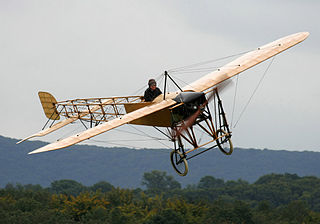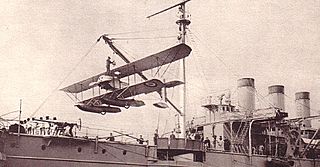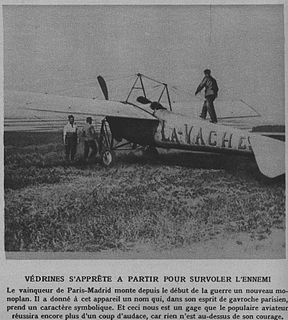Related Research Articles

The Amiot 354 was the last in a series of fast, twin-engine bombers which fought with the French Air Force in limited numbers during the Battle of France.

The Bloch MB.130 and its derivatives were a series of French monoplane reconnaissance-bombers developed during the 1930s. They saw some limited action at the beginning of World War II but were obsolete by that time and suffered badly against the Luftwaffe. After the fall of France, a few were pressed into Luftwaffe service.

The Blériot XI is a French aircraft of the pioneer era of aviation. The first example was used by Louis Blériot to make the first flight across the English Channel in a heavier-than-air aircraft, on 25 July 1909. This is one of the most famous accomplishments of the pioneer era of aviation, and not only won Blériot a lasting place in history but also assured the future of his aircraft manufacturing business. The event caused a major reappraisal of the importance of aviation; the English newspaper The Daily Express led its story of the flight with the headline "Britain is no longer an Island".

The Farman HF.20 and its derivatives were a family of reconnaissance aircraft produced in France shortly before and during the First World War. It was a refined version of the Farman MF.11 "Shorthorn" that did away with the type's distinctive landing skids, and incorporated design features from Henri Farman's designs. It entered service with the French, Belgian and Serbian armies in 1913, and with the British RFC and RNAS shortly after the outbreak of war. The type was also licence-built in the UK by Airco and Grahame-White.

The Caudron J Marine was an amphibious, two-seat, biplane equipped with floats and wheels, simiar to the earlier Caudron J floatplane.

The Blériot 111 was a French four-seat executive transport monoplane designed by André Herbemont. The first French aircraft to be fitted with a retractable landing gear, after six years development it was not ordered into production.
The Bernard 80 GR was one of three types built by different French constructors in response to a government call for an aircraft capable of setting new long distance records. A single engine monoplane with a crew of two, the 80 GR set an absolute record for flight over a closed circuit in April 1931, covering 8,960 km (5,569 mi). Modifications led to a new designation as the Bernard 81 GR but no more records were set despite several attempts.

The Blériot XIII was an experimental passenger-carrying aircraft built during 1910 by Recherches Aéronautique Louis Blériot. It is notable for setting a record for passenger carrying flights, and was probably intended as a developmental aircraft for the Blériot XXIV Limousine.
The Blériot 67 was a First World War French heavy bomber designed and built by Blériot for a 1916 competition Concours des Avions Puissants. Only a single prototype was built.

The Short S.36 was a British two-seat tractor biplane, built by Short Brothers for Frank McClean in 1911. It was later developed into the Short S.41 and Short S.45, which were the first of a long series of similar aircraft built for the RNAS and RFC.
The Blériot 53 was a twin-engined reconnaissance biplane designed and built in France during 1915,. The Fuselage was partly covered with fabric leaving most of the rear fuselage un-covered, all-flying tailplane and rudder at the rear extremities, with a tail-skid underneath. To accommodate the nose down attitude when fully loaded, due to the centre of gravity coinciding with the mainwheels, there was a long skid extending from the forward fuselage. Two 80 hp (60 kW) Le Rhône 9C rotary engines were mounted on struts between the wings with fuel and oil tanks in the nacelles behind them. Trials were also believed to have been carried out with 100 hp (75 kW) Anzani 10 radial engines.
The Bréguet 610 was a reconnaissance seaplane built in 1934 by the Bréguet company.
The Blériot XLIII was a First World War French reconnaissance plane designed and built by Blériot.
The Farman HF.10 was a reconnaissance aircraft built in France shortly before the First World War.
The Farman HF.16 was a reconnaissance aircraft built in France shortly before the First World War.
The Bleriot XXV was a high wing observation monoplane designed by Louis Bleriot. Only one aircraft was built, and it had a single seat for observational purposes.

The Blériot XXXVI Torpille was an observation monoplane designed in France by Louis Bleriot during the early 1910s. The Blériot XXXVIbisLa Vache was operated by Jules Védrines on several daring missions behind enemy lines in the early months of the war.
The Bleriot XXXIX was an single-seat observation monoplane designed in France by Louis Bleriot during the early 1910s.
The Bleriot XL was a two-seat observation sesquiplane designed in France by Louis Bleriot during the early 1910s. Its structure was made of metallic materials.
The Bleriot XLIV was an single-seat observation monoplane designed in France by Louis Bleriot during the early 1910s.
References
- ↑ "Bleriot XLII". www.airwar.ru.
- ↑ Parmentier, Bruno. "Blériot XLII". Aviafrance (in French). Paris. Retrieved 24 January 2019.